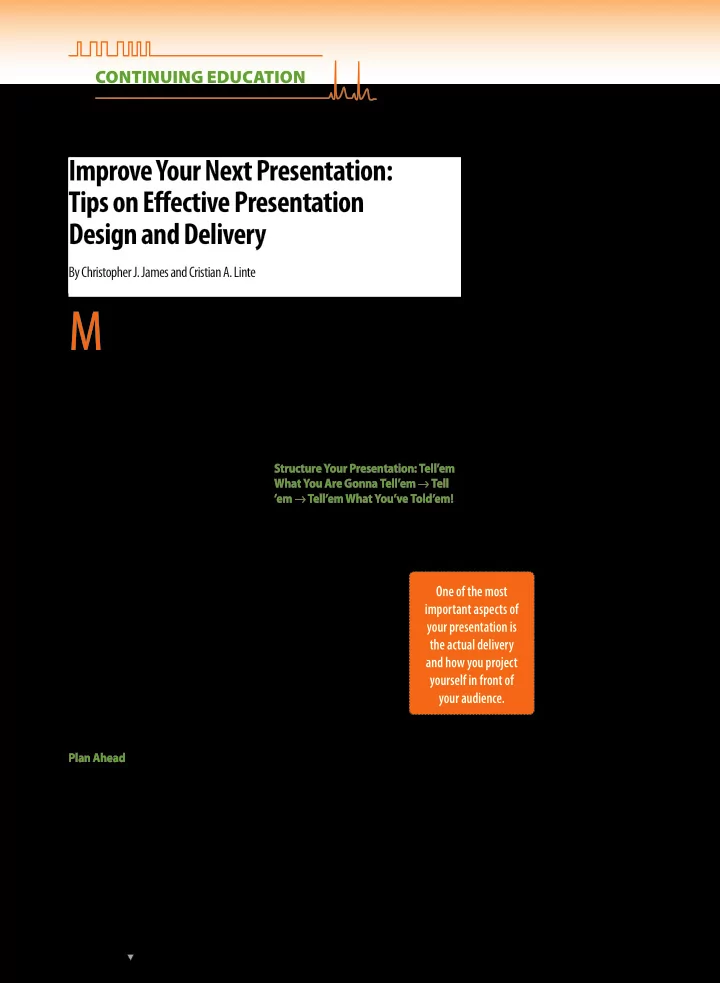

CONTINUING EDUCATION Improve Your Next Presentation: Think transition: lead the audience to the hypothesis and objectives for your research. Wrap up the introduction by Tips on Effective Presentation pointing out outstanding issues regarding the topic and how your work will address Design and Delivery them without putting down the work performed by other researchers (who By Christopher J. James and Cristian A. Linte may well be sitting in the audience). Develop the ideas you outlined in your introduction in the main body of your M any readers browsing this article One common instinct to overcome is presentation. Avoid unnecessary text and have communicated effectively squeezing all the work done during a four- use good visual aids to convey your mes- for years, while others may be year degree into that one presentation. sage, and help the audience understand seeking successful tips here on how to Nothing is more frustrating than a speaker and embrace your new findings. make their next presentation an out- switching through slides beyond the allot- Break the monotony by choosing title standing performance. Whichever the ted time, while the audience is packing up slides that emphasize your work, and aim case, please bear in mind that this arti- and rushing for the coffee break. Remem- to order your material in a nontraditional cle is not intended to “teach” how one ber, less is more—don’t overwhelm your fashion to keep the audience interested. becomes a great presenter but rather audience! Think “subtract”—not “add!” To maintain your own interest in the topic to provide helpful tips on presentation and deliver a fresh and exciting seminar, Structure Your Presentation: Tell’em design and delivery, hoping that some of create a few new slides and include some What You Are Gonna Tell’em → Tell them will trigger old knowledge and per- new material in each presentation—don’t ’em → Tell’em What You’ve Told’em! haps provide a few new ideas. just redeliver previous presentations. A focused and understandable com- Think about the central message—what Your audience will take home no more munication of ideas directly reflects upon is it that you want to say? What key than five key points. Use the rule of fives: one’s choice of appropriate visual aids message is your audience to take home? strategically choose five key concepts that that maximize impact and make a strik- Once you have decided best describe your work, ing difference in the strength and clarity on the message you want keeping in mind your of the presentation. While most people to convey, organize your One of the most summary slide to help appear comfortable standing in front of ideas logically to avoid you identify your key important aspects of an audience, an exciting and effective confusion. Imagine tell- messages, and emphasize your presentation is presentation entails a thorough organi- ing a story to a large audi- them throughout your the actual delivery zation of thoughts, slides, and visual aids ence who may not be very presentation. If the audi- and how you project carefully prepared ahead of time. Regard- familiar your work but ence can list the five key yourself in front of less of its technical content or the field want to know more about concepts that you have of expertise, there are a few simple steps it. Catch their interest and your audience. stressed, then you were that should be followed when preparing a attention from the start— successful. Also, since most successful presentation. avoid “filler” and techni- of us learn best by exam- cal jargon. Use an outline slide to build ples, use analogies to facilitate the under- Plan Ahead a road map of your presentation—just standing of difficult concepts and help Before putting together your presentation, don’t make it a dull (and uninformative) eliminate confusion. it is most appropriate to inquire about the “Intro, Methods, Results, and Conclu- Signal the beginning of the summary size and composition of the audience, what sion” sequence. and conclusion, but don’t summarize too they expect to achieve by attending your Devote the first few minutes to the soon. You don’t want the audience to leave presentation, and how much time you introduction of the topic and touch on the room and miss the punch line. Summa- have been allotted. These details will help the background information required rize your data, comment on the significance you identify the key messages and focus to set the stage for what you will be dis- of your findings, and always put your work your presentation to cater to the audience. cussing. Also try to avoid cliché state- back into the context of the challenges you ments such as “Disease X is the number outlined in the beginning. Finally, reiterate one killer in …” the audience most likely the main points in the context of a recom- Digital Object Identifier 10.1109/MPUL.2014.2309222 knows it. mendation for future work. Date of publication: 14 May 2014 78 IEEE PULSE ▼ MAY/JUNE 2014
Recommend
More recommend